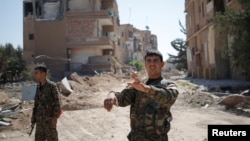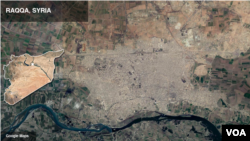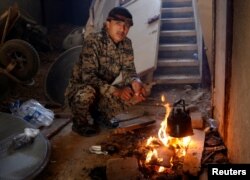With Islamic State in disarray in Raqqa, its fighters are switching to small-scale suicide attacks to fend off a rapid offensive by the U.S.-backed Syrian Democratic Forces (SDF) and a stream of coalition airstrikes, SDF commanders say.
Unlike past battles, when IS militants attacked SDF front lines with hundreds of fighters and car bombs, the terror group’s new strategy involves using small groups of suicide bombers – six or seven -- to cause large numbers of casualties, SDF commanders on the scene told VOA.
“This new method involves scattered attacks and most likely ends in the killing of all attackers,” SDF commander Agid Muhammad told VOA from Raqqa.
He said IS continues to rely on car bomb operations to hold onto its grip of the city, but its fighters avoid group attacks and large gatherings. He said the new tactic might be a result of repeated U.S.-led coalition airstrikes that have wiped out tens of IS fighters’ gatherings.
“IS thugs try to hide in public buildings such as schools and civilian homes to avoid airstrikes,” he said. “They come out from those buildings in small groups only when they know they can avoid airstrikes.”
But the new IS strategy is unlikely to help the fighters who have been struggling to hold territory across Iraq and Syria for months, U.S.-backed forces say.
“More than 40 percent of Raqqa is under our control now, and we will soon advance into the heart of the city,” SDF fighter Shoresh Kobane told VOA. He said the SDF forces, supported by coalition airstrikes, are pushing from the east and west across the Euphrates River to control southeast Raqqa, thus encircling the city.
Pentagon officials see the defeat of IS in its self-proclaimed capital as just a matter of time. But they expect the Syrian battlefield to become more complicated and crowded after Raqqa’s fall when U.S.-backed forces, pro-Syrian government troops and Russian jets likely will be fighting near each other.
Speaking Monday to reporters on his way to Germany to meet with European allies, U.S. Secretary of Defense Jim Mattis said the campaign to liberate Raqqa is the main focus, but he’s also looking “toward the next fight, and things are going on with that as well.”
“You have to play this thing very carefully,” Mattis said. “The closer we get, the more complex it gets.”
Mattis' comments come as U.S.-backed forces and militants allied with the government of Syrian President Bashar al-Assad have separately intensified efforts to control IS territory in southeast Syria and in the Euphrates River Valley.
The Pentagon considers the regions to be the next place to go against IS after Raqqa.
But Syrian government forces and Iranian-backed militias also have made efforts to move into the area, leading to a series of skirmishes in recent weeks -- including the downing of a Syrian government jet and two Iranian-made drones by U.S. aircraft.









